We may be compensated if you purchase through links on our website. Our team is committed to delivering honest, objective, and independent reviews on home products and services.
Levels are essential tools for any homeowner or professional looking to ensure their projects are straight, plumb, and true. From hanging a simple picture frame to constructing an entire house, these instruments provide the accuracy needed for quality results. Our article will explore various types of house levels, their uses, and how to choose the right one for your project.
Types of Levels
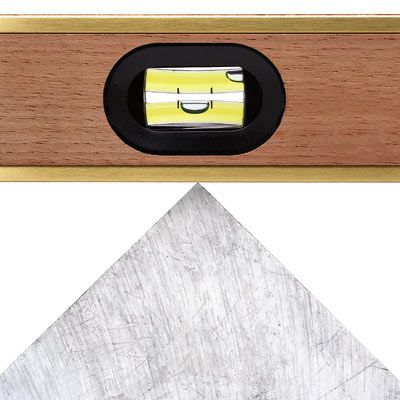
A level is an indispensable tool in construction and home improvement. The most basic type is the spirit level, which uses a liquid-filled vial with a bubble to indicate when a surface is level or plumb. On the more advanced end, laser levels project straight lines onto surfaces and are ideal for layout work.
Here are different types of house levels and when we recommend using them.
Torpedo
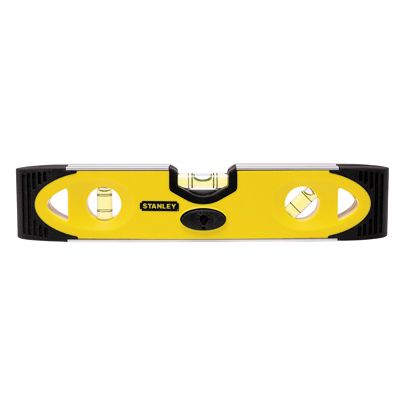
Torpedo levels are compact and versatile tools perfect for small jobs and tight spaces. These levels are ideal for the following tasks:
- Hanging pictures and shelves
- Installing plumbing fixtures
- Quick checks during framing or carpentry work
- Working in confined areas like cabinets or crawl spaces
How it works: Torpedo levels feature vials visible from both the front and top. This allows users to check for level and plumb simultaneously. Many models come with additional features, such as magnets for attaching to metal surfaces or built-in lights for improved visibility in low-light conditions.
Shown: Stanley magnetic torpedo level; about $10; homedepot.com
Bull’s-Eye

Bull’s-eye levels, also known as circular levels, are specialized tools designed for specific applications. They’re particularly useful for these tasks:
- Adjusting furniture legs for stability
- Ensuring flat surfaces are level in all directions
- Leveling appliances like washing machines or refrigerators
How it works: The bull’s-eye level rests on the surface. Users then adjust the object’s legs or sides until the bubble is perfectly centered within the circular vial. This design allows for quick and easy leveling in any direction.
Similar to shown: Kapro 1-⅝ inch circular level; about $3; homedepot.com
2-Foot I-Beam
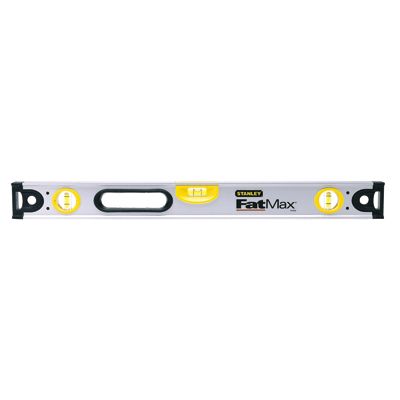
The 2-foot I-beam level is a versatile tool suitable for a wide range of general-purpose leveling tasks. Its compact size makes it easy to handle while still providing accurate readings. This level is ideal for the following:
- Hanging pictures, mirrors, and shelves
- Installing cabinets and rain gutters
- Plumbing posts and small structural elements
- Quick checks during home improvement projects
How it works: The lightweight I-beam design allows the level to be placed against objects both horizontally and vertically. It features vials for checking both level and plumb.
Similar to shown: Stanley 24-inch FatMax level; about $25; amazon.com
4-Foot
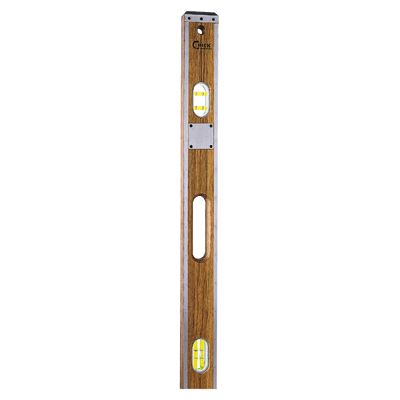
The 4-foot level is a staple in many toolboxes, offering increased accuracy and versatility for larger projects. This longer level is particularly useful for these projects:
- Installing cabinets, trim, and doors
- Laying floors and checking wall straightness
- Precision carpentry across extended surfaces
- Setting up gutters, drains, and concrete formwork
How it works: The extended length of a 4-foot level allows it to span longer distances for more accurate readings. It does this by minimizing the impact of small surface imperfections. Many professional-grade models feature curved vials for improved accuracy, with only the bottom vial in each pair indicating level at any given time.
Shown: Crick Tool Co. 48-inch wood level; about $200; cricktool.com
Plumb Bob
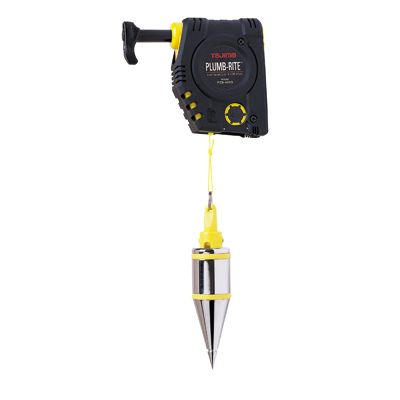
The plumb bob is one of the oldest and simplest leveling tools, yet it remains invaluable for certain tasks. This tool is great for the following:
- Building stairs and decks with precise alignment
- Ensuring proper framing alignment in multi-story construction
- Finding points vertically aligned above or below another point
- Positioning columns and vertical structural elements
How it works: Using gravity, the plumb bob consists of a pointed weight suspended on a string. Once fixed to a spot, the weight hangs perfectly plumb, providing a precise vertical reference line. Some modern plumb bobs, like the one shown, include built-in attachment mechanisms for easier use.
Shown: Tajima Plumb-Rite; about $55; acetool.com
Post Level
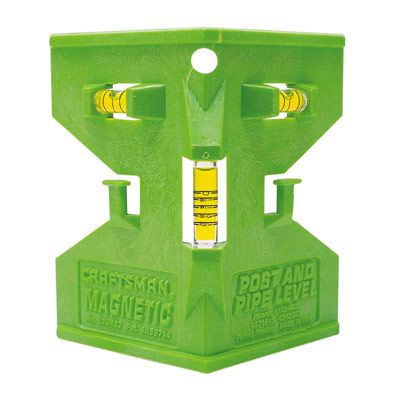
Post levels are specialized tools designed for a specific task in construction and landscaping. They’re useful for these projects:
- Aligning vertical structural elements in construction
- Ensuring proper alignment of mailbox posts and outdoor lighting fixtures
- Installing plumbing waste lines (magnetic models)
- Setting fence posts, deck posts, and columns
How it works: The post level wraps around the corner of a post or column, providing level readings in two directions simultaneously. Magnetic models offer the added convenience of hands-free use on metal surfaces.
Similar to shown: Johnson post level; about $7; lowes.com
Laser Chalk Line

Laser chalk lines combine traditional chalk line technology with modern laser precision. These tools are a good choice for the following:
- Creating plumb lines for wallpaper installation or paint edges
- Establishing level reference lines for trim, cabinets, and tile work
- Hanging pictures, shelves, and wall-mounted fixtures
- Layout work in large rooms or open spaces
How it works: When held against a wall or fixed in place, the tool projects level or plumb laser lines (or both) onto the surface. Some models are self-leveling for added convenience, while others may include additional features such as stud finders.
Shown: Black & Decker Crosshair laser level; about $50; lowes.com
Rotating Laser Level

Rotating laser levels offer unparalleled accuracy and efficiency for large-scale projects. These sophisticated tools are ideal for these tasks:
- Creating precise slopes for walks, driveways, and drainage systems
- Ensuring walls are plumb and square during construction
- Installing floors, ceilings, and wainscoting over large areas
- Laying out forms for foundations and concrete work
How it works: The self-leveling turret unit can sit on the floor or be mounted it on a tripod. It projects two rotating laser beams, one vertical and one horizontal, to create a 360-degree reference plane.
Similar to shown: Johnson Level & Tool self-leveling rotary laser level kit; about $530; northerntool.com
What Are the Outer Lines on a Level For?
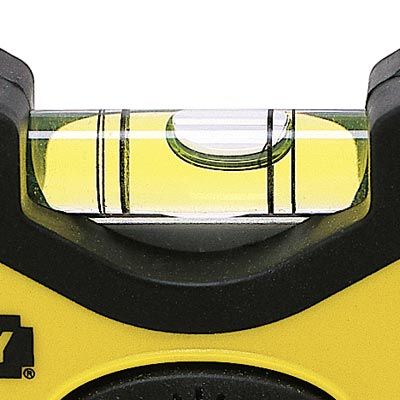
Many spirit-level vials feature two sets of lines, which serve distinct purposes:
- Inner lines: A bubble centered between the two lines indicates a perfectly level or plumb surface.
- Outer lines: These lines represent a 2% grade (approximately ¼ inch per foot of run). When the bubble touches one of these outer lines, it indicates the proper slope for waste lines, sidewalks, and rain gutters to ensure proper drainage.
How To Check Your Level’s Accuracy
A level must be well-calibrated to perform its job accurately. Here’s a simple method to check your level’s accuracy:
- Place the level on a flat surface and note the bubble’s position.
- Rotate the level 180 degrees (end over end) and place it in the exact same spot.
- Check the bubble’s position again. If the level is accurate, the bubble should be in precisely the same place as before.
If you find discrepancies, you can adjust some levels with replaceable vials. It’s best to replace levels that you can’t calibrate or, at minimum, mark the inaccurate vial to avoid future errors. We recommend frequently checking your level’s accuracy, especially before starting significant tasks that demand precision.
Choosing the Right Level for Your Project
Choosing the appropriate level for your task can impact the quality and efficiency of your work. Consider the following factors when choosing a level:
- Budget: While quality tools are an investment, there are options available at various price points to suit different needs and budgets.
- Frequency of use: For occasional DIY tasks, a basic spirit level might suffice, while professionals may benefit from investing in more durable and precise tools.
- Project scale: Larger projects may require longer levels or rotating laser levels for accuracy over greater distances.
- Specific applications: Specialized levels, such as post levels or bull’s-eye levels, can make some tasks much easier and more accurate.
Maintaining Your Levels
Proper care and maintenance of your levels ensure their longevity and continued accuracy. Here are some simple maintenance tips for house levels:
- Clean your levels after each use, especially if exposed to dust, dirt, or moisture.
- Handle levels with care to avoid drops or impacts that could affect their accuracy.
- Regularly check the calibration of your levels, especially before critical projects.
- Store levels in a dry place to prevent damage to the vials or electronic components.
